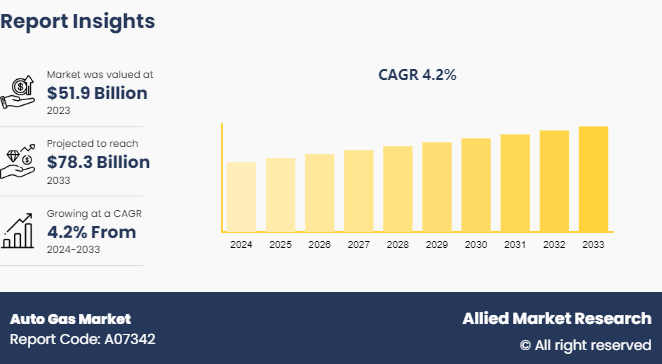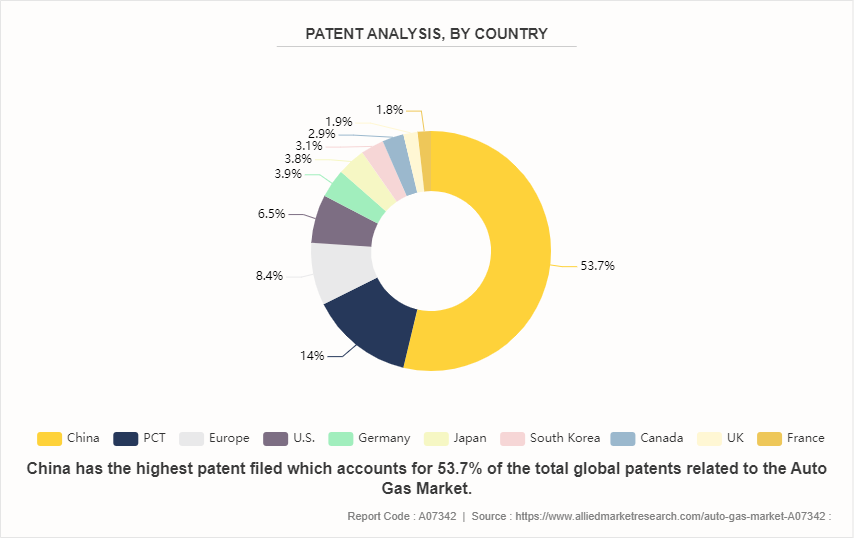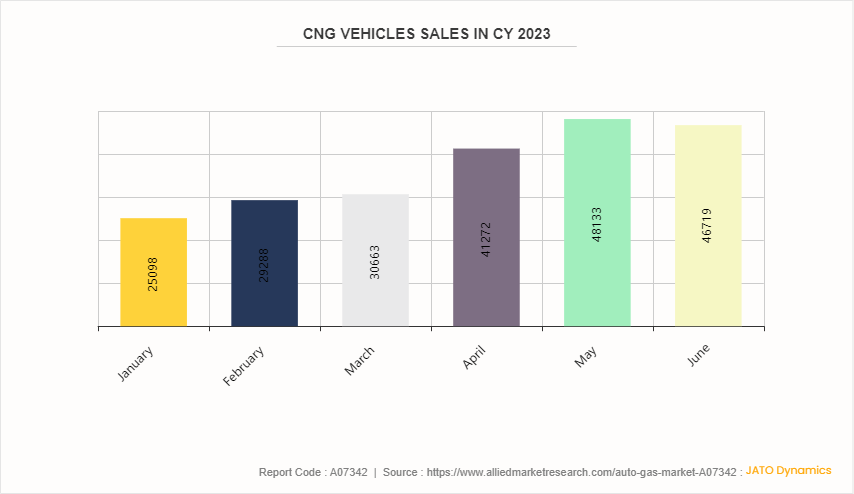Auto Gas Market Research, 2033
The global auto gas market was valued at $51.9 billion in 2023, and is projected to reach $78.3 billion by 2033, growing at a CAGR of 4.2% from 2024 to 2033.

Market Introduction and Definition
Auto gas, commonly known as automotive gas or gasoline, is a volatile, flammable liquid used as a fuel in internal combustion engines. It is derived from crude oil through refining processes such as distillation and catalytic cracking. Auto gas primarily consists of hydrocarbons, including alkanes, cycloalkanes, and aromatic compounds. It is characterized by its high energy content, which provides efficient combustion and power generation in vehicles.
In addition, auto gas has a low boiling point, which contributes to its volatility and ease of vaporization. Its combustion produces a mixture of gases, including carbon dioxide and water vapor, and pollutants like carbon monoxide and nitrogen oxides. The properties of auto gas, such as its octane rating, influence engine performance and fuel efficiency, making it a critical component in modern transportation.
Key Takeaways
- The Auto gas market study covers 20 countries. The research includes a segment analysis of each country in terms of value ($Billion) for the projected period 2024-2033.
- More than 1, 500 product literatures, industry releases, annual reports, and other such documents of major Auto gas industry participants along with authentic industry journals, trade associations' releases, and government websites have been reviewed for generating high-value industry insights.
- The study integrated high-quality data, professional opinions and analysis, and critical independent perspectives. The research approach is intended to provide a balanced view of global markets and to assist stakeholders in making educated decisions to achieve their most ambitious growth objectives.
Key Market Dynamics
The increasing adoption of alternative fuels is poised to drive significant growth in the auto gas market. As environmental concerns escalate and regulatory pressures intensify, consumers and industries are shifting towards cleaner fuel options. Auto gas, or liquefied petroleum gas (LPG) , is emerging as a popular alternative due to its lower emissions compared to traditional gasoline and diesel. Governments globally are incentivizing the use of auto gas through subsidies, tax benefits, and infrastructure development, further accelerating its adoption. Technological advancements in auto gas conversion kits and the expansion of refueling networks are making it more accessible and convenient for consumers. In addition, rising oil prices and the economic benefits of auto gas, such as reduced fuel costs and maintenance expenses, are encouraging both commercial fleets and individual drivers to switch. This trend is not only fostering a more sustainable automotive sector but also opening new opportunities for manufacturers and service providers within the auto gas market, contributing to its robust growth trajectory.
The growth of the auto gas market is significantly hampered by the limited refueling infrastructure. Unlike conventional fuels such as gasoline and diesel, which benefit from an extensive network of refueling stations, auto gas (liquefied petroleum gas or LPG) is constrained by a sparse and unevenly distributed infrastructure. This limitation poses a substantial barrier for consumers considering the switch to auto gas vehicles, as the convenience of readily accessible refueling options is a crucial factor in their decision-making process. The high initial costs associated with developing new refueling stations and retrofitting existing ones further exacerbate the issue, leading to slow expansion rates. In addition, regulatory hurdles and varying government policies across different regions contribute to the inconsistency in infrastructure development. This inadequate infrastructure not only deters potential buyers but also undermines the efforts of automotive manufacturers and environmental advocates who promote auto gas as a cleaner and more economical alternative. Consequently, addressing the infrastructure deficit is vital for the widespread adoption and sustained growth of the auto gas market.
The increased focus on sustainability presents a significant opportunity for the growth of the auto gas market. As environmental concerns and regulations intensify, there is a growing demand for cleaner and more efficient energy sources in the transportation sector. Auto gas, or liquefied petroleum gas (LPG) , is considered a greener alternative to traditional gasoline and diesel due to its lower carbon emissions and reduced particulate matter. Governments worldwide are implementing policies and incentives to promote the use of alternative fuels, including auto gas, to combat air pollution and reduce dependency on fossil fuels. This regulatory support, combined with technological advancements in auto gas conversion kits and infrastructure development, is driving market expansion. In addition, consumers are becoming more environmentally conscious and are seeking sustainable fuel options, further boosting the demand for auto gas. The lower cost of auto gas compared to conventional fuels also provides economic benefits, encouraging its adoption. Overall, the shift towards sustainability is creating a favorable environment for the auto gas market, positioning it as a key player in the transition to cleaner transportation solutions.
Patent Analysis of the Global Auto Gas Market
China dominates the automotive gas market with a significant 53.7% share of global patents, reflecting its leading role in innovation. The Patent Cooperation Treaty (PCT) accounts for 14.0% of filings, indicating substantial international collaboration. Europe holds 8.4% of the patent share, showcasing a strong regional presence, while the U.S. contributes 6.5%, underlining its active involvement. Germany and Japan follow with 3.9% and 3.8% respectively, highlighting their significant yet smaller roles. South Korea, Canada, the UK, and France have shares ranging from 1.8% to 3.1%, collectively representing the diverse global innovation landscape in automotive gas technology.

Market Segmentation
The auto gas market is segmented into type, application, and region. By type, the market is classified into compressed natural gas, liquefied petroleum gas, liquefied natural gas, and others. By application, the market is divided into passenger vehicles, commercial vehicles, two-wheelers, and others. Region-wise the market is analyzed across North America, Europe, Asia-Pacific, and LAMEA.
Competitive Landscape
The major players operating in the auto gas market include BP plc, China Petroleum & Chemical Corporation, Flogas Britain Limited, Aygaz A.S., Lange & Co GmbH, Total Energies SE, Westfalen GmbH, Shell Plc, SHV Energy N.V., Likitgaz Distribution, and Industry Inc.
Regional Market Outlook
Asia-Pacific has experienced robust economic growth. Increase in demand for Compressed Natural Gas (CNG) and Liquefied Petroleum Gas (LPG) is set to drive significant growth in the auto gas market in the Asia-Pacific region. Factors such as rise in environmental concerns, stringent emission regulations, and cost-effectiveness propel the adoption of CNG and LPG as alternative fuels. Countries such as China, India, and Thailand are leading this shift, supported by government initiatives and subsidies to promote cleaner fuel usage. The transition to CNG and LPG reduces vehicular emissions and enhances energy security, making them attractive options for both consumers and fleet operators in the region.
- Cities in the Asia-Pacific region rank among the most polluted globally. CNG and LPG vehicles emit fewer pollutants compared to diesel and petrol vehicles, making them attractive options for enhancing urban air quality. Consequently, many countries are adopting global emission standards. CNG and LPG vehicles are considered practical steps toward meeting these stricter environmental regulations.
- In November 2023, The Indian government committed to significantly expanding the network of CNG stations, aiming to increase the number from 6, 000 to 17, 700 by 2030. This initiative gained momentum in October with the launch of the 12th City Gas Distribution (CGD) bidding round, aimed at closing gaps in the existing gas infrastructure, which is expected to substantially drive the growth of the CNG vehicle market.
- In June 2023, the National Economic Council (NEC) approved a proposal by the National Automotive Design and Development Council (NADDC) to begin large-scale production of electric vehicles and CNG-powered vehicles in Nigeria.
- In January 2023, Suzuki Motor Corporation (SMC) announced plans to power its CNG vehicles using cow dung. This initiative is part of an MoU signed between Maruti Suzuki and the National Dairy Development Board (NDDB) , Asia's largest dairy manufacturer, and is a key element of SMC's growth strategy looking toward 2030.
- In March 2022, Maruti Suzuki India Limited launched the Dzire with S-CNG technology. Equipped with an advanced K-series Dual Jet, Dual VVT 1.2L engine, the Dzire S-CNG delivers a peak power of 57kW at 6000 rpm, 98.5 Nm torque, and an impressive mileage of 31.12 km/kg.
- Therefore, Asia-Pacific is projected to emerge as a dominant force in the Auto gas market throughout the forecast period.
The Growth of the Auto Gas Market will be Driven by the Increasing Sales of CNG Vehicles.
The growing sales of Compressed Natural Gas (CNG) vehicles are set to drive the expansion of the auto gas market. As consumers and governments prioritize eco-friendly alternatives to gasoline and diesel, CNG vehicles are becoming increasingly popular due to their lower emissions and cost-effectiveness. This shift is supported by advancements in CNG technology, expanded refueling infrastructure, and favorable regulatory policies promoting clean energy. Consequently, the rising adoption of CNG vehicles is expected to significantly boost demand for auto gas, leading to robust market growth and investment opportunities in the coming years.

Industry Trends
- The auto gas market, encompassing liquefied petroleum gas (LPG) and compressed natural gas (CNG) used as automotive fuels, is experiencing significant shifts driven by technological, environmental, and regulatory factors.
- One key trend is the increasing adoption of auto gas vehicles due to their lower emissions compared to traditional gasoline and diesel engines. This trend is particularly evident in countries with stringent emission regulations and strong government incentives. For example, in India, the government’s push for cleaner fuels has resulted in a surge in CNG vehicle sales, supported by an expanding network of CNG refueling stations.
- Technological advancements are also shaping the market. Innovations in engine design and fuel systems have improved the performance and efficiency of auto gas vehicles, making them more attractive to consumers. For instance, the development of bi-fuel systems, which allow vehicles to switch between auto gas and gasoline, provides greater flexibility and range. Companies like Ford and Fiat are offering factory-fitted bi-fuel vehicles, catering to the growing demand for versatile and eco-friendly transportation options.
- Another significant trend is the rising cost-effectiveness of auto gas. Compared to traditional fuels, auto gas often has a lower price point, providing economic benefits for both consumers and fleet operators. This cost advantage is driving increased adoption among commercial fleets, including taxis, delivery vehicles, and public transportation. In Europe, countries such as Italy and Poland have seen a notable increase in auto gas usage in their transportation sectors.
- Moreover, environmental concerns are pushing auto manufacturers and consumers toward sustainable fuel alternatives. Auto gas, with its lower carbon dioxide and particulate emissions, aligns well with global efforts to reduce the environmental impact of transportation. Governments are introducing subsidies and tax benefits to encourage the use of cleaner fuels, further propelling market growth.
Key Sources Referred
- Ericsson Mobility Report
- IEA
- IATA
- Our World in Data
- The National Economic Council (NEC)
- National Automotive Design and Development Council (NADDC)
- The National Institution for Transforming India (NITI Aayog)
Key Benefits For Stakeholders
- This report provides a quantitative analysis of the market segments, current trends, estimations, and dynamics of the auto gas market analysis from 2024 to 2033 to identify the prevailing auto gas market opportunities.
- The market research is offered along with information related to key drivers, restraints, and opportunities.
- Porter's five forces analysis highlights the potency of buyers and suppliers to enable stakeholders make profit-oriented business decisions and strengthen their supplier-buyer network.
- In-depth analysis of the auto gas market segmentation assists to determine the prevailing market opportunities.
- Major countries in each region are mapped according to their revenue contribution to the global market.
- Market player positioning facilitates benchmarking and provides a clear understanding of the present position of the market players.
- The report includes the analysis of the regional as well as global auto gas market trends, key players, market segments, application areas, and market growth strategies.
Auto Gas Market Report Highlights
| Aspects | Details |
| Market Size By 2033 | USD 78.3 Billion |
| Growth Rate | CAGR of 4.2% |
| Forecast period | 2024 - 2033 |
| Report Pages | 310 |
| By Type |
|
| By Application |
|
| By Region |
|
| Key Market Players | BP plc, Lange & Co GmbH, China Petroleum & Chemical Corporation, Total Energies SE, Shell plc, Westfalen GmbH, Flogas Britain Limited, Likitgaz Distribution and Industry Inc., Aygaz A.S., SHV Energy N.V. |
The auto gas market was valued at $51.9 billion in 2023 and is estimated to reach $78.3 billion by 2033, exhibiting a CAGR of 4.2% from 2024 to 2033.
BP plc, China Petroleum & Chemical Corporation, Flogas Britain Limited, Aygaz A.S., Lange & Co GmbH, Total Energies SE, Westfalen GmbH, Shell Plc, SHV Energy N.V., Likitgaz Distribution, and Industry Inc. are the top companies to hold the market share in Auto Gas.
Advancements in gas technology and growing demand for vehicles are the drivers of Auto Gas Market in the globe.
Asia-Pacific is the largest regional market for Auto Gas.
Passenger vehicles is the leading application of Auto Gas Market.
Loading Table Of Content...


